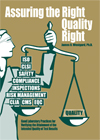Essays
What went Wrong with CLIA
There's a struggle to find the right direction in managing the quality of laboratory testing today. Many people think that the problems with analytical quality have been solved, that it’s time to set a new direction and focus on pre-analytic and post-analytic parts of the total testing process. One of the main causes of degrading quality in laboratory testing is the slow decay of the CLIA regulations - which we chronicle here. (Preview)
- CLIA Final Rules (1992)
- CLIA Final Rules (2003)
- CMS Guidance for "Equivalent QC" (2004)
- What's the Point?
- References
Laboratory tests have become a commodity in the healthcare marketplace. By “commodity,” we mean that laboratory tests are now so commonly available from so many different sources that they are evaluated mainly on the basis of their cost, with the assumption that the quality of the test results is the same, regardless of the source of testing. Sources now include commercial reference laboratories, laboratories in hospitals, point-of-care locations, physician offices, community clinics, nursing homes, hospices, pharmacies, health fairs, as well as home-care testing. Given this wide variety of sources of laboratory tests, the assumption that quality is same everywhere is unlikely. In fact, there may be serious
deficiencies in quality from any or all of these sources.
It is not a popular position to criticize the quality of laboratory testing, particularly in the US where laboratories are under pressure to do more and more testing with fewer and fewer resources, including less and less quality control. But we believe it is necessary to confront the complacency that has developed in the last 15 years as labs have internalized the CLIA-88 regulations (Clinical Laboratory
Improvement Amendments of 1988) as the standard for quality management[1]. It is important to recognize that CLIA established minimum standards for quality in order to bring all laboratories
under the same umbrella of regulation. In practice, these minimum standards have now become maximums in many laboratories. Still more laboratories have entirely escaped the application even of
these minimum standards.
During the period of the CLIA-88 regulations, more tests have been “waived,” which means that laboratories can perform those tests without being subject to the minimum standards of quality and
laboratory inspection. When CLIA-88 was implemented in 1993, there were some 67,000 labs that performed only waived testing. By 2006, that number had almost doubled to 117,418 laboratories. In
addition, certain physician-performed tests are excluded from the CLIA rules for quality management, eliminating another 16,443 labs in 1993 and 38,814 labs by 2006, more than doubling. That means that today in the US, out of the total of 198,232 registered laboratories, 156,232 – over three-quarters of all laboratories – are not subject to the minimum CLIA requirements for quality management.
Of the remaining laboratories, 20,026 are classified as “compliance labs” subject to CMS inspections. Only 15,957 are accredited by professional organizations that are deemed to have standards at least as demanding as the CLIA standards. From our perspective, it is clear that CLIA has failed to achieve the objective of establishing a uniform quality for laboratory testing in the US and may, in practice, have actually resulted in lower standards of quality than before CLIA. It is now necessary to adopt a better approach, at least for those laboratories that are truly interested in providing quality to their physicians and patients.
While we have not been fans of ISO standards (International Standards Organization) in the past, we are starting to believe that the ISO 15189 guideline for medical laboratories [2] may provide the best opportunity for improving the analytical quality of laboratory testing processes today.
We recognize this will be a hard sell to many US laboratories, but the following pages will demonstrate how government regulations have failed, how inspection and accreditation programs have failed, and because of these failures, laboratories are now failing to provide the quality needed for critical laboratory tests being utilized in national and international patient treatment guidelines. We will try to substantiate those points in this chapter to convince you that there is a need to improve the analytical quality of laboratory testing.
 We invite you to read the rest of this chapter
We invite you to read the rest of this chapter
You can get this chapter and many more articles on Good Laboratory Practices by purchasing the Assuring the Right Quality Right manual in our online store. You can download the Table of Contents and additional chapters here.
You can also enroll in the Quality Management and Design of Analytical Systems online course.
